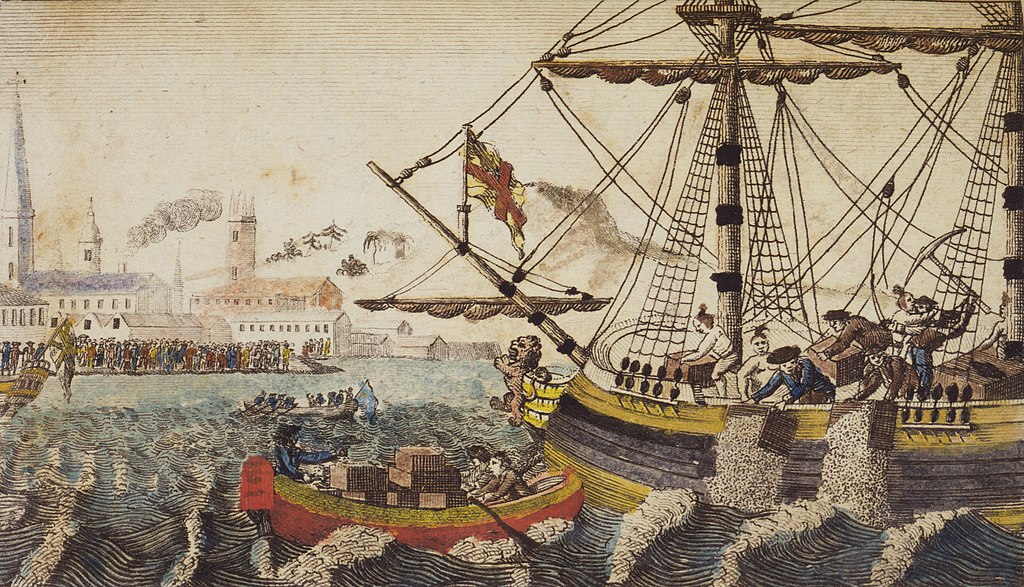
Published: N. Currier, 1846.
U.S. Library of Congress, Control Number 91795889
Public Domain
In 1773, the British Parliament enacted the Tea Act to protect the East India Company, a company that though private had become important in Britain’s imperial designs in India. Not only did the act impose a monopoly for the company, but it could only be sold in the American colonies by those commissioned by the company. And that cut out the colonial merchants who had made money previously selling the tea. Since their ships no longer had to dock in England and be taxed, they came straight to America to be sold by the authorized agents at higher prices than before. The British had assumed the colonists, who liked tea, would pay the price. They were wrong.
Considerable resentment had built up in the colonies owing to the Sugar Tax (1764) followed by the Stamp Act (1765). The Sugar Act put duties on various items including tea while the Stamp Act required payment of fee for a stamp on official documents. Both laws were unpopular and seen as an attempt by the British Parliament to recoup the losses in the recent war between France and England. The colonists protested strongly about how bad these acts were and how, being distant from London, they seemed to have little representation. Demonstrations took place, some peaceful and some not, against the British. The Stamp Act was repealed but replaced with a new Townshend Acts (1767) that put import duties on essential goods. This caused even more resentment and anger in the American colonies as well.
When the Tea Act was passed on May 10, 1773, it angered people in England and America. British citizens now had to pay more for the East India Company tea. This led to the growth of smuggled tea (mostly Dutch) in both countries. Many made a small fortune with smuggled tea (like John Hancock). Protests and smuggling led the British to send troops to Boston. Rather than calming things down, the presence of the British troops made things worse. The Boston Massacre of 1770 was still in the minds of many. Adding to it was the feeling that the British were trying to undermine the col0nies. Many stopped drinking tea (although many drank the smuggled Dutch) which meant sales of the East India Company tea went down in the colonies. Attempts at curtailing the smuggling had not been wholly successful either by the British. The Townshend Acts, which imposed duties on many imported items, was rescinded in 1772 but not the duties on tea. The British dropped the price of the tea so that the smuggled tea was more expensive. Smuggling continued but as a protest for the citizen’s right not the be taxed without representation. Ships bearing tea to New York and Philadelphia were turned away by the colonists. Tensions had really reached a boiling point.
When a shipment of tea reached Boston on 29 November 1773, they were unable to unload the tea as the dock workers refused to unload. Thomas Hutchinson, the royal governor, refused to send the ships back and demanded the workers unload the tea and duties paid. After a meeting with the governor failed to take place on 16 December, many decided to take it into their own hands. Although the numbers vary, it is believed 100 men (mostly of the Sons of Liberty group but there were others) dressed in Indian garb (not as Indians as some suggest but rather garb worn during the French and Indian War that soldiers wore that were ponchos and soot streaks) boarded the three ships. They were armed with hatchets, axes, and pistols. And their outfits helped conceal their identities. They had formed into three groups, boarded the ships, and demanded the key to the hatch. Tea chests were then torn open and most of their contents dumped into Boston harbor. In total about 100,000 pounds of tea was dumped, worth about 9,000 pounds sterling making it one of the most expensive tea dumps in history.
Aftermath
The British government was enraged and responded with the Coercive Acts of 1774. They would become known by the colonists as the Intolerable Acts. It created a series of measures that resulted in the closing of Boston harbor until the cost of the destroyed tea was made. Other things such as repealing the colonial charter of Massachusetts occurred. General Thomas Gage was sent in to command the British forces in North America. Up until the imposition of the Coercive Acts, many had stayed neutral or on the sidelines waiting to see what would happen next. This action made many moderates realize that something was very wrong and looked like Britain was usurping their rights as British subjects. It became about sovereignty, that they had a right to have a voice on whether to tax themselves or not. It became clear to many the British were becoming a tyranny they had to oppose. Colonial resistance was made stronger leading to the American Revolution.
Sources:
Khandelwal, Pallavi. “The Boston Tea Party | Key Facts, Information and History.” Revolutionary War, 4 Mar. 2020, www.revolutionary-war.net/the-boston-tea-party.
“The Boston Tea Party.” HISTORY, 24 Nov. 2009, www.history.com/this-day-in-history/the-boston-tea-party.
“Tea Act – Definition, Timeline and Facts | HISTORY.” HISTORY, 9 Nov. 2009, www.history.com/topics/american-revolution/tea-act.
,

